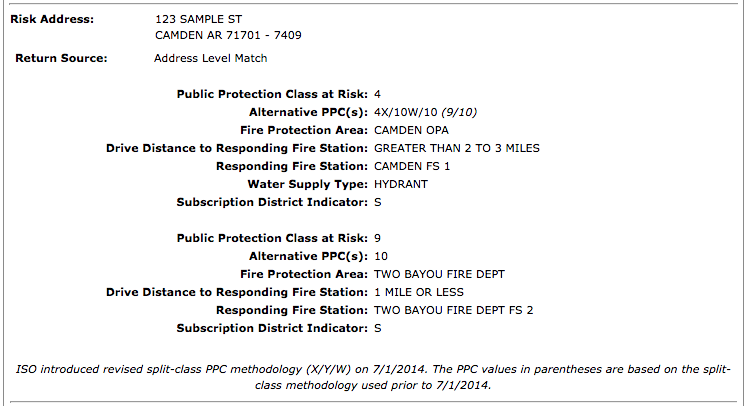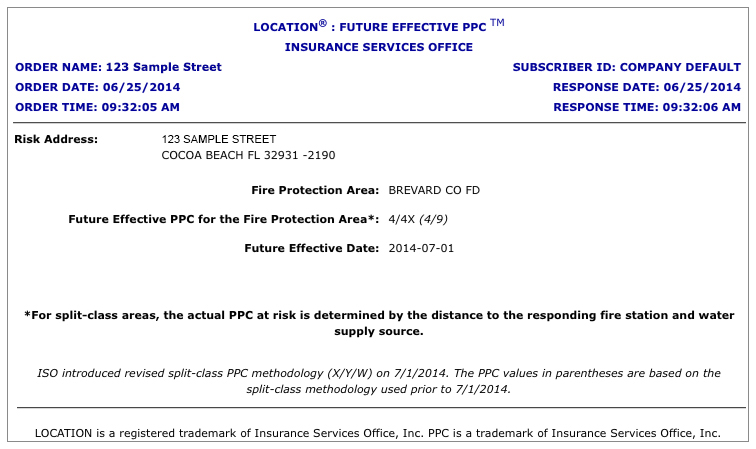
ISO's Public Protection Classification (PPC™ ) program measures and evaluates the effectiveness of fire-mitigation services in communities throughout the country. For each fire protection area, ISO assigns a Public Protection Classification code — a number from 1 to 10. Class 1 represents exemplary fire protection, and Class 10 indicates that the area's fire-suppression program doesn't meet ISO's minimum criteria. The LOCATION® PPC Report provides the PPC code, alternative PPC and water supply type (if applicable), corresponding fire protection area name for an address, and supplemental information, such as the name of — and the drive distance to — the responding fire station. PPC Reports are available in detailed or abbreviated formats. Abbreviated reports display only the PPC (and any dwelling PPC or subscription district indicator) for an address.
On July 1, 2014, the modernization updates to the ISO Public Protection Classification (PPC) structure became effective, introducing new split classifications that recognize favorable loss experience relative to these new categories. ISO has filed corresponding relativities/loss costs to complement the new “X”, “Y”, and 10W classifications. Reports generated through the Passport Online platform will include these new values. For customers not adopting the new program, the split 9 and 8B equivalent values will be displayed in parentheticals. Please see the example reports below.

The detailed PPC Report provides the following information:
|
Risk Address |
The address used to match against the database. |
|
|
Return Source |
Shows whether the match is on an address level or a ZIP-Code level. |
|
|
Public Protection Class at Risk |
Displays the PPC code(s) for the risk address shown.
In many jurisdictions, ISO develops split classifications (for example, 5/5X or 5/9). See "PPC Split Classifications" for more information. Some communities may receive alphanumeric codes (e.g., 8A, 8B, 10C, or 10W.) See "Alphanumeric Classifications" for more information. |
|
|
Dwelling PPC at Risk |
Displays the Dwelling PPC code(s) for the risk address shown. If the risk does not have a dwelling PPC code, the report will not display this field. Dwelling PPC classification is an extension of the PPC rules in four states (ID, LA, MS, WA) that provides a reduction of the PPC for residential risks. Within those states, the report won’t display the Dwelling PPC classification if the specific risk location is in an area where Dwelling Class doesn’t apply. The code can be a single class or a split class (for example, 5, 5/8, or 5/9). The code can also be alphanumeric – i.e., 8A or 6/8A. |
|
|
Alternative PPC(s) |
Displays all of the PPC options not selected for the risk location. In a split-class fire protection area, the Alternative PPC field contains all PPC options existing in the fire protection area, but not applicable to the particular risk location.
|
|
|
Alternative Dwelling PPC(s) |
Display all of the dwelling PPC options not selected for the risk location. See "Alternative PPCs" for details. Applies only in Idaho, Louisiana, Mississippi, and Washington. |
|
|
Fire Protection |
Contains the name of the Fire Protection Area (Fire District) serving the risk address. For a risk address not located within any Fire Protection Area (unprotected area), the report will display “- Not in a fire district -”. |
|
|
State-Specific Field |
Displays additional state-specific information (for example, Fireman's Relief Code in New Jersey). You will find this field, if applicable, on reports for risks in Mississippi, New Jersey, North Carolina, North Dakota, and Washington. If the risk does not have any state-specific information, the report will not display the field. |
|
|
Subscription District Indicator |
Displays an "S" if the risk address is within a subscription fire protection area. A subscription fire protection area is one where residents or companies choose to pay to get fire-protection services. If the risk is not within a subscription fire protection area, the report will not display this field. |
|
|
Statistical Placement Indicator |
Displays a “Y” if ISO determined the PPC for the risk using a statistical-placement algorithm. This field indicates that the address of the risk is missing in the commercial street databases. This field will not display if LOCATION did not invoke the statistical-placement algorithm. |
|
|
Drive Distance to Responding Fire Station |
Displays the drive distance to the fire station in one-mile bands.
|
|
|
Responding Fire Station |
|
|
|
Water Supply Type |
Water supply type applies only to risks within split-class fire protection areas. This field specifies the applicable water source for a particular risk. The field will not appear if the water supply type is not available or not applicable for the risk. The possible water supply types are:
|
If LOCATION does not return information on the location of the nearest fire hydrant (or other approved source of water), the report will display a split classification (e.g., 5/5X). Generally, the first class (Class 5 in the example) applies to properties within 1,000 feet of a hydrant or other approved source of water. The second class (Class 5X in the example) applies to properties beyond 1,000 feet. You should use other information about the location of hydrants or other ISO-approved water sources to determine the correct PPC for the risk. If LOCATION returns information about the location of hydrants (or other approved sources of water), the report will display a single PPC (for example, 5).
The system can return split classifications for both the dwelling and commercial PPC codes.
|
|
In LOCATION, a split classification indicates that the risk is within five miles of a responding fire station, but ISO cannot confirm the distance to, or the availability of, an approved source of water. In most states, ISO assigns Class 10W for properties between five and seven road miles from a responding fire station when creditable water is confirmed within 1,000 feet of the property (excluding non-ISO jurisdictions and NC). A class 10 is assigned for properties greater than five but less than or equal to seven road miles from the responding fire station without an ISO creditable water source within 1,000 feet of the property and for all properties greater than seven road miles from the primary responding fire station. |
PPC codes are not entirely numeric. Some alphanumeric classifications include:
|
8B |
Recognition for a superior level of fire protection in areas with limited water supply, where the PPC would otherwise be Class 9. |
|
8A |
Reflects a Washington state-specific dwelling class rule providing recognition for a superior level of fire protection in areas with limited water supply, where the PPC would otherwise be Class 9. |
|
9A |
Reflects a Washington state-specific dwelling class rule indicating a dwelling property that is more than five road miles from a responding fire station but still within a fire department’s legal response boundary. |
|
10C |
Reflects a Mississippi state-specific dwelling class rule recognizing a certified fire department in a Class 10 area. |
|
10W |
Reflects a risk property that is greater than 5 but less than 7 miles from the primary responding fire station and is within 1,000 feet of an ISO creditable water supply . |
List of Possible PPC Values Returned by LOCATION:
NOTE: If you have elected not to adopt the X, Y, W methodology, you can ignore all values with X, Y, or W.
|
1 |
3 |
5 |
7 |
9 |
|
1X |
3X |
5X |
7X |
9/10 (MS only) |
|
1Y |
3Y |
5Y |
7Y |
10 |
|
1/1X |
3/3X |
5/5X |
7/7X |
10W |
|
1/1Y |
3/3Y |
5/5Y |
7/7Y |
10W/10 |
|
1/8B |
3/8B |
5/8B |
7/8B |
|
|
1/9 |
3/9 |
5/9 |
7/9 |
|
|
1/10 (LA only) |
3/10 (LA only) |
5/10 (LA only) |
7/10 (LA only) |
|
|
2 |
4 |
6 |
8 |
|
|
2X |
4X |
6X |
8B |
|
|
2Y |
4Y |
6Y |
8X |
|
|
2/2X |
4/4X |
6/6X |
8Y |
|
|
2/2Y |
4/4Y |
6/6Y |
8/8X |
|
|
2/8B |
4/8B |
6/8B |
8/8Y |
|
|
2/9 |
4/9 |
6/9 |
8/8B |
|
|
2/10 (LA only) |
4/10 (LA only) |
6/10 (LA only) |
8/9 |
|
|
|
8/10 (ID & LA only) |
List of Possible Dwelling Class Values Returned by LOCATION:
NOTE: Dwelling class values are applicable for the bureau states of ID, LA, MS, and WA.
|
1 |
3 |
5 |
7/10 |
|
1/7 |
3/7 |
5/7 |
8 |
|
1/8 |
3/8 |
5/8 |
8A |
|
1/8A |
3/8A |
5/8A |
8/8A |
|
1/10 |
3/10 |
5/10 |
8/10 |
|
2 |
4 |
6 |
9 |
|
2/7 |
4/7 |
6/7 |
9A |
|
2/8 |
4/8 |
6/8 |
9/10 |
|
2/8A |
4/8A |
6/8A |
10 |
|
2/10 |
4/10 |
6/10 |
10C |
The Future Effective PPC Report provides the future Public Protection Classification code for the fire protection areas that will experience a change within the next three months. You can order the report only with a detailed PPC Report. You will receive a report only if the return source is an address-level match.

The Future Effective PPC Report provides the following information:
|
Fire Protection Area |
This field provides the name of the fire protection area(s) serving the risk address shown. |
|
Future Effective PPC for the Fire Protection Area |
Provides the future PPC for the fire protection area(s) serving the risk address. The report will display this field only if you order the service and if applicable to the fire protection area shown. (The service is not available in bureau states.) Split class X and Y future effective PPC’s will contain the equivalent split 9 or 8B values in parentheses (see the above example).
|
|
Future Effective Dwelling PPC for the Fire Protection Area |
At this time, Future Effective Dwelling PPC is not available in the bureau states of Idaho, Louisiana, Mississippi, and Washington. |
|
Future Effective Date |
Provides the date the future PPC becomes effective. If multiple future classifications apply to the fire protection area shown, the report will display each future PPC individually with its corresponding effective date. |